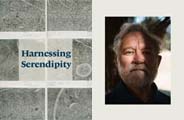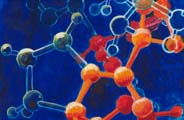
Scientific Discipline
Biophysics, Structural Biology
Host Institution
University of California, Berkeley
Current Position
Dr. Nogales is also a professor of biochemistry, biophysics and structural biology at the University of California, Berkeley and a senior faculty scientist at Lawrence Berkeley National Laboratory.
Current Research
Structural Studies of Macromolecular Assemblies
Biography
Biophysicist Eva Nogales is studying molecular machines that perform some of the central tasks in living organisms: passing chromosomes from parent to child and transferring information from genes to proteins. She discovered that one machine performs work by falling apart and that another looks like a gingerbread man. Above all, her studies have shown that cellular machines, unlike machines of steel, are very flexible structures.
In high school, Nogales was inspired by math's ability to explain physical laws. She therefore decided to study physics at university—an unusual choice at that time for a woman in Spain. She had never heard of biophysics until by chance she met the director of the British synchrotron, who suggested that she apply physical methods to biological samples. She subsequently obtained a doctorate in biophysics in England, studying a protein called tubulin, the target of the anticancer drug taxol. This protein is the Lego-like building block of microtubules—unstable cylinders that give cells their shape and serve as conveyer belts for cellular components.
In 1993, Nogales moved to Berkeley with her boyfriend (now her husband), who had been offered a position at the Lawrence Berkeley National Laboratory. "There I met the best person I could ever have encountered in my career—Ken Downing," Nogales says.
Downing was an expert in electron crystallography, which uses an electron microscope to investigate the structures of large molecules that don't easily form 3-D crystals and therefore can't be studied with x-ray crystallography, the more common technique. Happily for Nogales, he wanted to recruit someone who was familiar with tubulin biology.
Nogales's postdoctoral work in Downing's lab produced the first high-resolution structure of a soluble protein, tubulin. Nogales's breakthrough, featured on the cover ofNature in 1998, helped scientists make sense of previous findings about microtubules, which are constantly forming and falling apart. Her subsequent work described the structure of the open sheet that tubulin units form before zipping up lengthwise into a cylinder. It also described the protofilament peels that microtubules shed when they break down. Moreover, these intermediate structures have important functions in cells, Nogales surmises, and she hopes to determine those functions and how they are performed.
Microtubules grab onto chromosomes when cells are dividing, helping to split them apart and delivering the correct complement of genetic material to each daughter cell. But scientists had long wondered how such an unstable structure could perform this function, especially since the chromosome attachment site appeared to be at the end that falls apart. Nogales discovered that, in yeast, proteins in a complex called Dam1 assemble themselves into a ring around a microtubule as if they were forming a napkin ring around a handful of dry spaghetti. As the microtubule falls apart at its front end, its protofilaments curve out, pushing the ring backward. And as the ring slides, it pulls the chromosome with it. "It is a beautiful molecular solution for how to move the chromosome in a continuous fashion without the ring falling off and using the energy of the rail it is moving on," Nogales says.
To work on transcription—the reading of genes—Nogales has been brave enough to study the human system, which is more complex and difficult to handle than that of simpler organisms. Her group studies a large protein complex called TFIID (transcription factor IID), which sits on DNA and recruits the other proteins needed to initiate transcription. Using cryo-electron microscopy (electron microscopy on frozen samples) and image reconstruction, the researchers produced the first overall views of TFIID. Previously, some individual modules of the complex had been studied with x-ray crystallography, which traps proteins into rigid shapes. But images of the entire machine revealed it to be very flexible. "It is like it is breathing," Nogales says. "This motion completely changes the surface properties and how it can interact with DNA and other proteins. That knowledge is going to be essential in understanding how it works."
Transcription transfers information from genes into long strands of messenger RNA. Those strands are read to make proteins, a process called translation. The protein makers are ribosomes, but a complex called EIF3—the gingerbread man—makes sure that ribosomes don't start work prematurely. "The gingerbread man brings in all the factors needed to initiate translation and positions them in the right place with respect to the messenger RNA," Nogales says. She also discovered that he puts his left leg in the way, like a foot in a door, to prevent two ribosomal subunits from getting together until one of them finds the correct starting point on the messenger strand.
A corollary of this work might lead to better ways to combat hepatitis C virus, which hijacks cellular translation machinery to make its own proteins. Nogales described how a special structure in the viral RNA interacts with EIF3 to initiate its own translation. If a drug could be found to block this interaction, the virus would be unable to reproduce.
Nogales has been surprised at how dynamic some protein complexes are. Some can make movements half as big as themselves, especially if they have hinges that flip modules out. "The common thread that we see is that a complex can propagate local chemical reactions into very large movements," she says.
Nogales hopes to take her work to a new level by studying giant complexes, such as transcriptional preinitiation complexes, that form only for fleeting moments. With this goal in mind, she is developing new purification and imaging techniques.
Since women are not well represented in biophysics, Nogales is often asked about her career by aspiring scientists. She says she has never been discriminated against because of gender, and encourages young women to enter the field. But she also says that motherhood is a tough choice for any faculty member because of the long hours in the lab and classroom. Her children are aged 10 and 12.
Nogales's most important advice to young women is to be as assertive as possible in their professional lives. "Don't say that someone is treating you differently because you're a woman," she says. "If you think something is happening, take action in a constructive way. Instead of wasting your energy victimizing yourself, concentrate on doing the best you can."
Articles & News
Research Papers
Selected Research Papers




